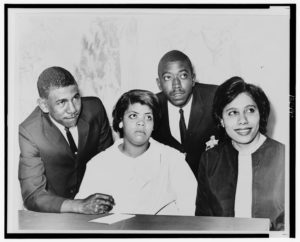
By Natalia Holliday, Web Editor
“[Public school education] is a principal instrument in awakening the child to cultural values, in preparing him for later professional training, and in helping him to adjust normally to his environment…Such an opportunity, where the state has undertaken to provide it, is a right which must be made available to all on equal terms.”[1]
And with that, a unanimous Supreme Court under Chief Justice Earl Warren struck down legal segregation in public schools in one of America’s greatest moral victories, Brown v. Board of Education (Brown I). Brown I overturned the “separate but equal” doctrine promulgated by one of America’s greatest moral disasters, Plessy v. Ferguson, but only in its application to public school education.[2] In the follow-up case, Brown II, the Court set forth a vague timeline for the implementation of integration: “with all deliberate speed,”[3] permitting States to basically avoid public school desegregation.
What is clear in retrospect is that Linda Brown, the African-American schoolgirl at the center of the historic case, had years of activism ahead of her. Brown passed away this year on March 25th at the age of 75.[4] In remembrance of her history-changing life, we take a look at the case and the woman who pushed America at least one step closer to achieving equality among the races.
Born in 1942,[5] Brown grew up in a perhaps surprisingly diverse neighborhood in Topeka, Kansas.[6] Throughout her childhood, she faced a strange reality in which she played with both her black and white friends at home, but by school-time, the children were split up and sent to different schools. For Brown and the other African-American children, this meant taking a bus across town while the white children went to Sumner School, just a few blocks from the neighborhood.[7]
Brown was too young to understand why the Topeka schools insisted she and her friends be separated, but Brown’s parents, Oliver and Leola Brown, understood the reason all too well. In an interview with NPR, Mrs. Brown recalled how she tried to explain it to Linda. In the simplest and most honest of terms, Mrs. Brown elucidated Topeka’s rationale: “It was because her face was black.”[8]
Mr. Brown rejected this future for his daughter. Encouraged by the NAACP, he and twelve other African-American parents approached some of the 18 white schools in Topeka and attempted to enroll their children.[9] After they were (unsurprisingly) turned away, the tension in Mr. Brown rose to an intolerable level.[10] The NAACP filed a class action suit with 13 parents. Thanks to alphabetical order, Oliver Brown was the first-listed plaintiff, making his daughter the child America has come to associate with the desegregation of public schools.[11]
By the time the Supreme Court handed down the decision in 1954, Brown was a shy junior high student and not thrilled to be the center of such attention.[12] Her classmates couldn’t believe the quiet girl could have had such influence, and it took until 1959, when Brown was in high school, for her to realize the national and historic impact of the case.[13]
From there, she recognized the role she could continue to play in bringing an end to discrimination in education, and there was no shortage of work. In 1979, Brown teamed up with the ACLU and reopened her quasi-namesake case on behalf of her own children, then enrolled in the Topeka school district, because the district let its desegregation efforts fall by the wayside.[14] It took until 1993 for the district to implement a new integration plan, one year shy of Brown I’s 40th anniversary.[15]
Outside her federal court activities, Brown also worked on the ground as an Program Associate for her sister’s organization, the Brown Foundation for Educational Equity, Excellence, and Research.[16] In that position, she helped establish four libraries for preschool children.[17] Brown also spent part of her career teaching in Head Start programs to give educational opportunities to underprivileged families and lecturing on civil rights across the country.[18]
Brown’s passing on March 25th forces us to bear in mind two realities that are as relevant now as they ever were. For one, legal facial discrimination against African-Americans occurred less than a lifetime ago. Brown passed at age 75, younger than many Americans still living. Although the Jim Crow era may seem like an artifact for the history books, it isn’t so distant in the past that residual mentalities have totally faded out. From the black Hermione debate[19] to a revival in school segregation,[20] the nation seems to be actively demonstrating that racial tensions aren’t quite put to rest.
Especially relevant, though, is the reminder that the nation moves when ordinary people stand up. Mid-20th century America was an era of social and political movements, and the early 21st century seems to be following in its footsteps. With the Women’s March, Black Lives Matter, the March for Our Lives, and other national displays of frustration over stagnant policy, we may be able to look to the past to get an idea of the future. As one news anchor put it while reflecting on Linda Brown’s life, it is often the “ordinary heroes” who “fundamentally [transform] the country.”[21]
Sources
[1] Brown v. Board of Ed. of Topeka, Shawnee County, Kan., 347 U.S. 483, 493 (1954)
[2] Id. at 495.
[3] Brown II
[4] https://www.theguardian.com/education/2018/mar/28/linda-brown-obituary
[5] https://www.biography.com/people/linda-brown-21134187
[6] https://www.npr.org/sections/thetwo-way/2018/03/26/597154953/linda-brown-who-was-at-center-of-brown-v-board-of-education-dies
[7] Id.
[8] Id.
[9] https://www.theguardian.com/education/2018/mar/28/linda-brown-obituary
[10] Id.
[11] Id.
[12] Id.
[13] Id.
[14] Brown v. Bd. of Educ. of Topeka, Shawnee County, Kan., 892 F.2d 851, 855 (10th Cir. 1989), cert. granted, judgment vacated, 503 U.S. 978 (1992), and opinion reinstated, 978 F.2d 585 (10th Cir. 1992)
[15] https://www.theguardian.com/education/2018/mar/28/linda-brown-obituary
[16] http://brownvboard.org/
[17] Id.
[18] Id.
[19] https://www.cnn.com/2016/06/06/entertainment/jk-rowling-hermione-cursed-child/index.html
[20] https://www.pbs.org/wgbh/frontline/article/the-return-of-school-segregation-in-eight-charts/
[21] https://www.msnbc.com/morning-joe/watch/remembering-the-life-of-linda-brown-1195877443943?playlist=associated
